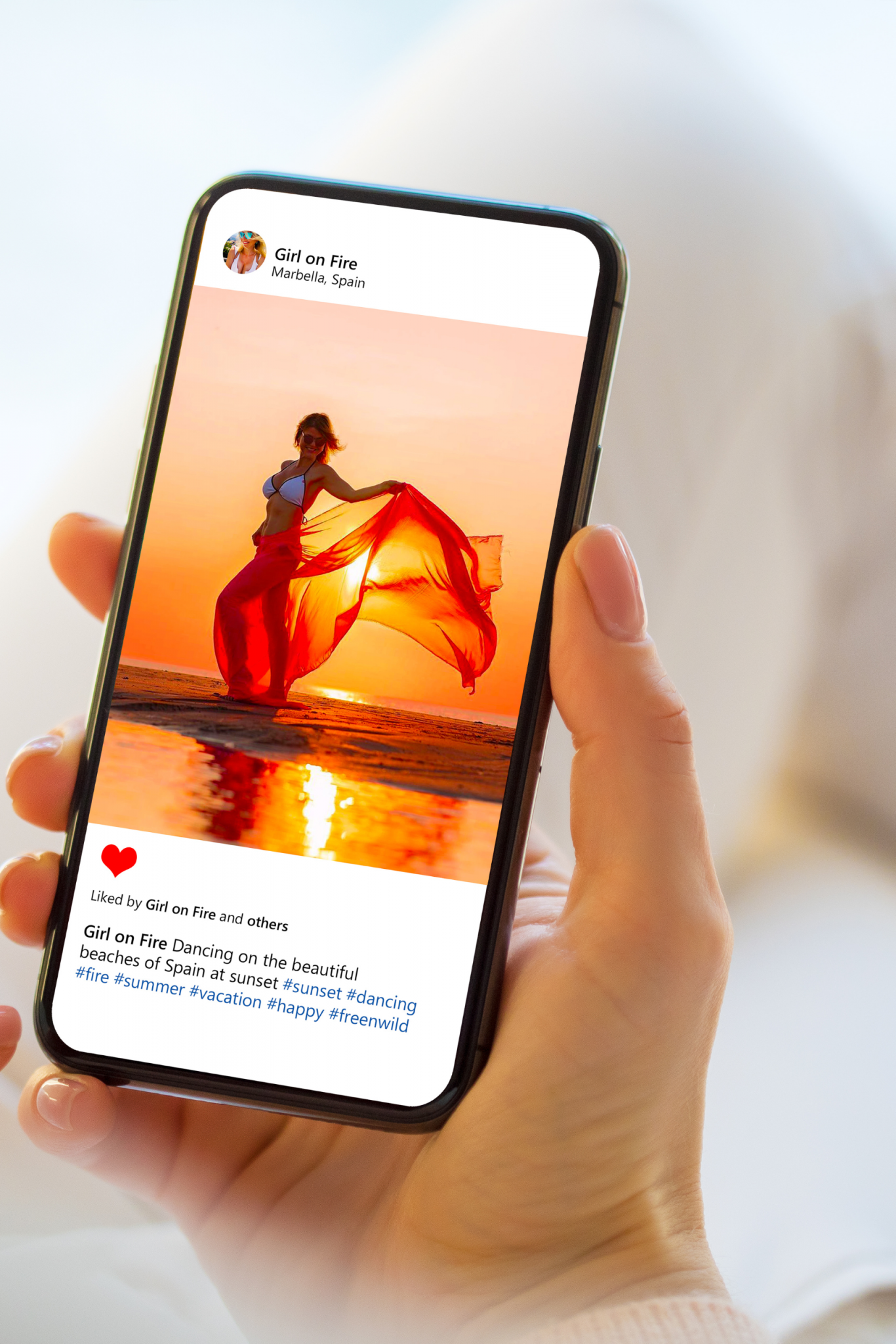ADAPTING TO MOBILE-FIRST CONTENT CONSUMPTION:
Why Vertical Video is Ruling Instagram Reels, TikTok, and Snapchat
In recent years, vertical video has taken the social media world by storm, dominating platforms like Instagram Reels, TikTok, and Snapchat. The rise of vertical video has revolutionized content creation and consumption, catering to the mobile-first habits of today's digital audience. With its unique aesthetic and design, vertical video has become a preferred format for engaging with users on social media. In this blog post, we will explore why vertical video is ruling Instagram Reels, TikTok, and Snapchat, and how it is shaping the future of content creation.
Mastering Vertical Video
In recent years, the landscape of digital content consumption has dramatically shifted towards mobile-first experiences. With the majority of social media users accessing platforms via smartphones, vertical video has become the preferred format. This shift is driven by the natural way users hold their devices, making vertical videos more intuitive and immersive. As a result, platforms like Instagram Reels, TikTok, and Snapchat have optimized their interfaces to prioritize vertical video content, encouraging creators and brands to adapt their strategies accordingly.

The Science Behind Vertical Video
Why It Captures Attention Better
As with any marketing strategy, measuring the success of vertical video campaigns is crucial. Key performance indicators such as view counts, engagement rates, shares, and conversion rates provide valuable insights into how your vertical videos are performing. Social media platforms offer robust analytics tools that allow you to track these metrics and refine your content strategy accordingly. Additionally, A/B testing different video styles and formats can help identify what resonates best with your audience. By continuously analyzing and optimizing your vertical video content, you can ensure sustained engagement and achieve your marketing goals.

Best Practices for High-Quality Content

Optimizing Your Video Content for Mobile
Staying ahead in the dynamic world of social media requires constant adaptation to new trends and challenges. Vertical video presents unique opportunities for creativity, but it also comes with its own set of challenges. For instance, ensuring that important visual information is not cropped out of the vertical frame can be tricky. To overcome this, creators need to be innovative with their use of space and storytelling techniques. Jumping on trends such as quick transitions, visual effects, and incorporating trending audio or music can make vertical videos more appealing. By staying current with platform-specific trends and user preferences, brands can maximize their reach and engagement.
Understanding the Vertical Video Phenomenon
Vertical video has emerged as a defining format of the digital age, characterized by its portrait orientation and 9:16 aspect ratio that is tailor-made for smartphone screens. This format aligns with the global surge in smartphone usage, fundamentally altering how audiences engage with video content. Unlike traditional horizontal videos, vertical videos are designed for the ease of mobile users, offering a full-screen experience without the need for device rotation or screen adjustments. This smart alignment with how people use their phones has pushed vertical video to the top of the social media game.
The evolution of vertical video is closely intertwined with the dynamics of social media platforms that prioritize immediacy and intimacy in content sharing. As platforms such as Instagram Reels, TikTok, and Snapchat continue to prioritize and refine their vertical video offerings, they tap into the user’s desire for content that is not only easily accessible but also deeply immersive. Loving vertical videos is part of a bigger trend where convenience and direct engagement are the name of the game.
The rise of vertical video shows how our media habits are shifting to mobile-centric experiences. As people rely more on their smartphones for everything from entertainment to news and socializing, the need for content that fits this mobile lifestyle has surged. Vertical video perfectly meets this demand, offering a format that’s natural and engaging for today’s mobile-first users.
The Mobile-First Approach to Content Consumption
As digital consumption habits shift overwhelmingly in favor of smartphones, creators are increasingly adopting a mobile-first mindset in their content strategies. This places a premium on the seamless integration of content into the daily flow of mobile users, emphasizing ease of access and immediate engagement. Vertical video, with its user-friendly orientation and full-screen display, is at the heart of this approach. It negates the need for physical adjustment of devices, an aspect particularly crucial for platforms populated by quick-scrolling users seeking instant gratification from content, like Instagram Reels, TikTok, and Snapchat.
This mobile-first approach means we need to rethink content creation from scratch, making mobile optimization a core part of the process instead of an afterthought. It highlights the need to create content that fits smartphone specs and aligns with the fast-paced lifestyle of today’s viewers. Creators are pushed to get creative with vertical video, experimenting with new ways to tell stories, design visuals, and engage viewers within this format.
The focus on mobile-first content highlights a bigger trend in digital media: customizing digital experiences to match how people actually use and prefer to consume content. As the digital landscape continues to evolve, the mobile-first approach, with vertical video at its core, represents a key strategy for creators and platforms aiming to capture the attention and engagement of the mobile-centric audience.
How Vertical Video is Changing Content Creation
The pivot to vertical video has prompted a fundamental transformation in the way content creators approach social media. This shift isn’t just about flipping the camera orientation; it’s about rethinking visual storytelling to fit a vertical frame. Creators now need to craft narratives and visuals that captivate viewers within this narrower space, often by using tighter compositions and making sure key elements and characters stand out to keep the audience engaged.
The move to vertical video has sparked a burst of new editing techniques. Editors are experimenting with dynamic cropping, vertical transitions, and split-screen effects tailored to enhance the storytelling experience in a vertical format. Such creative adjustments are critical in maintaining the pace and visual interest of the content, making each second count in an environment where user attention is fleeting.
Additionally, this evolution has underscored the importance of direct, personal engagement with the audience. Vertical videos offer a sense of immediacy and intimacy that is unparalleled, pushing creators to adopt a more authentic and relatable tone. This intimacy creates a deeper connection between creators and viewers, enhancing the impact of the content.
In navigating the challenges and opportunities presented by vertical video, creators are expanding their toolkit, employing innovative strategies to captivate and retain their audience’s attention. This continuous adaptation and experimentation with vertical video aesthetics are setting new standards for content creation, signaling a vibrant future for storytelling in the digital era.
Vertical Video Aesthetic: Crafting Engaging Content
To nail the vertical video look, content creators need to dive into the details of this unique format. The vertical frame requires a special approach to composition, where the skill is in utilizing the limited space to convey a story compellingly.
Focusing on verticality, creators are pushed to get creative with drawing the viewer’s eye upward, making the most of the elongated screen. This could mean using strong vertical lines or arranging elements to naturally guide attention through the video.
Detail is crucial in vertical video. Every bit of screen space counts, so smart creators strategically place key elements like text and graphics to enhance, not block, the viewer’s experience. Clever use of color and contrast can make a big impact, helping important content stand out on a mobile screen.
Moreover, the vertical video aesthetic isn’t just about what’s in the frame but also how movement within that frame is orchestrated. Movement should be purposeful, either to highlight a narrative moment or to keep the viewer engaged through dynamic storytelling. Transition effects, when used purposefully, can add a layer of sophistication to vertical videos, facilitating smooth narrative progression or offering surprises that keep viewers hooked.
The unique constraints of vertical video push creators to get innovative and think outside the box, leading to fresh ideas and techniques that connect with the mobile-first audience. As the digital world keeps evolving, nailing the vertical video style will be crucial for creating standout content in a sea of visual noise.
Vertical Video on Instagram Reels, TikTok, and Snapchat
Platforms like Instagram Reels, TikTok, and Snapchat have positioned vertical video at the core of their user experience, creating an environment where creators and audiences alike thrive on this immersive format. These social media giants have effortlessly added vertical video features, offering intuitive tools and filters that spark creativity within this format. Users on these platforms aren’t just watching—they’re actively engaging with content through likes, comments, and shares, boosting the reach and impact of vertical videos. Each platform’s unique features, from Reels’ smooth looping to TikTok’s viral challenges and Snapchat’s fleeting stories, show how versatile vertical video is for diverse storytelling and audience interaction. This integration highlights how these platforms are adapting to users’ changing preferences, keeping vertical video a vital and vibrant part of the social media scene.
The Future of Vertical Video: Trends and Predictions
As we look ahead in digital storytelling, vertical video is on the brink of major changes. Innovations in technology and evolving viewer preferences are about to kick off a new era for this format. In the near future, AR and VR could mix with vertical video, giving viewers an even more immersive and interactive experience. Imagine vertical videos that not only captivating but also allow viewers to engage with content in three-dimensional spaces, bridging the gap between the viewer and the content creator in unprecedented ways.
Moreover, artificial intelligence (AI) will play a significant role in refining the content creation process for vertical videos. AI-driven analytics and editing tools could offer insights into viewer engagement and preferences, enabling creators to produce content that resonates more deeply with their audience. Additionally, these technologies could streamline the editing process, making sophisticated effects and transitions more accessible to creators without extensive technical backgrounds.
Personalization and interactivity are also set to become key trends in the vertical video landscape. As platforms evolve, we might see features that allow viewers to interact with content in real-time, choosing story paths or engaging with creators directly through the video. This level of personalization will not only elevate the viewer experience but also open new avenues for storytelling and audience engagement.
As creators and platforms navigate these trends, vertical video will continue to redefine the boundaries of digital storytelling, offering viewers and creators alike a more engaging, inclusive, and dynamic medium.
Vertical vs. Horizontal Video: Which is Better for Social Media?
Vertical video is revolutionizing the way content is consumed on mobile-first platforms like Instagram Reels, TikTok, and Snapchat. Brands can create more engaging and immersive experiences for their audiences on these platforms. From crafting high-quality vertical content to leveraging platform-specific features and staying ahead of emerging trends, the potential for vertical video is vast. As the digital landscape continues to evolve, adapting to vertical video will be crucial for brands looking to enhance their social media presence and connect more effectively with their audiences.
